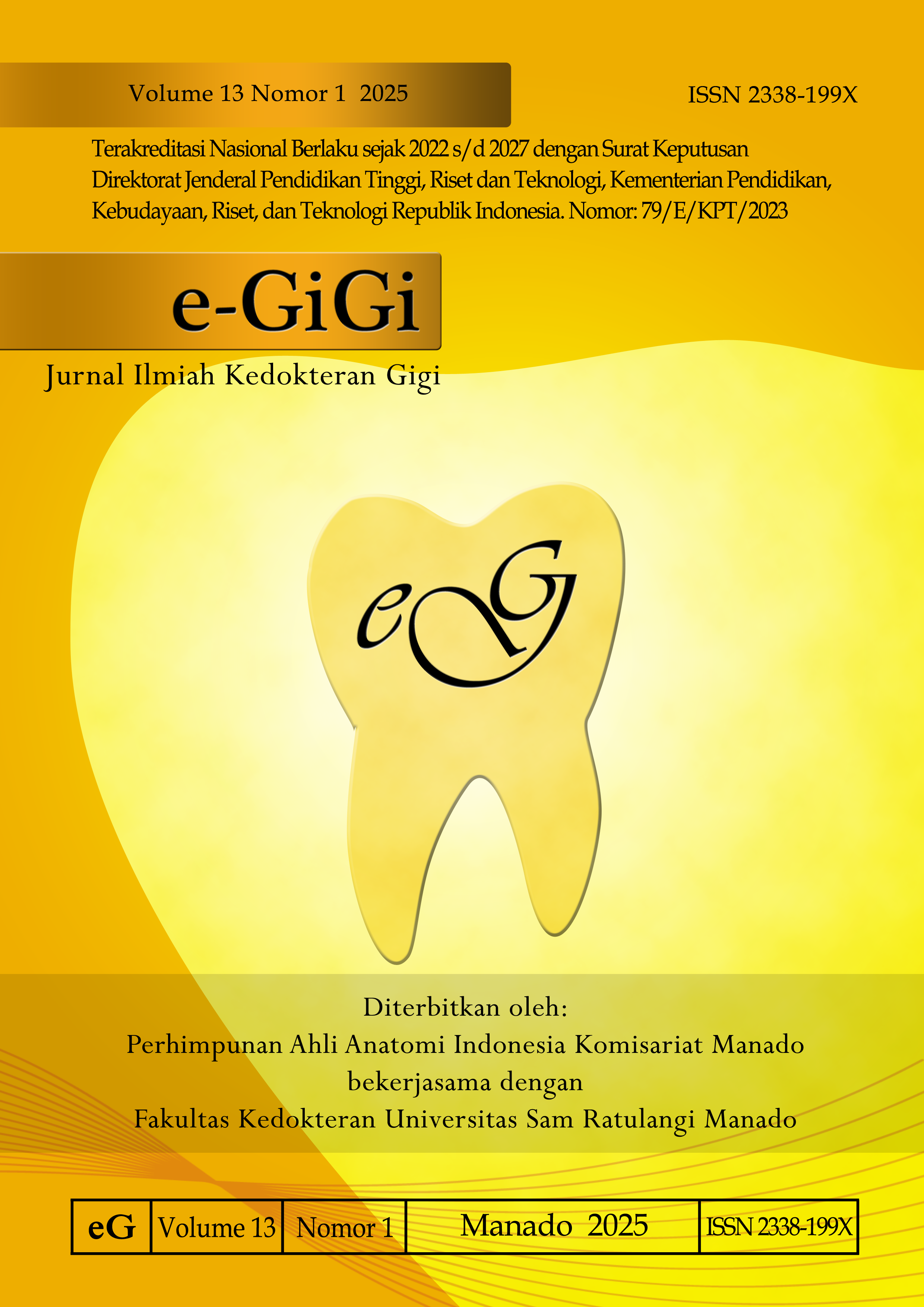Pengaruh Tingkat Keparahan Karies terhadap Kebiasaan Mengunyah Satu Sisi pada Anak Usia 12-14 Tahun
DOI:
https://doi.org/10.35790/eg.v13i1.52980Abstract
Abstract: Unilateral chewing can cause tooth malposition and abnormalities in jaw growth and development. This study aimed to determine the influence of caries severity as the etiology of unilateral chewing habits. This was an analytical study with a cross sectional design. Subjects were junior high school students at Gamping District, Sleman, Special Region of Yogyakarta obtained by using simple random sampling as many as 211 subjects. Unilateral chewing assessment was carried out using the direct method by letting the child chewed gum. Measurement of caries severity was carried out using the index introduced by Shimono. Data analysis was carried out using the chi-square test to compare the severity of caries in the two chewing groups. The results showed that 129 (61.14%) out of 211 subjects had unilateral chewing habit. The severity of caries in the unilateral chewing group was moderate (21.33%), high (20.85%), and low (18.96%), respectively. Meanwhile, in the bilateral chewing group, the severity of caries was low (17.54%), moderate (11.85%), and high (9.54%). There was no significant difference (p>0.05) between the severity of caries in the unilateral and the bilateral chewing groups. In conclusion, children with unilateral chewing habits tend to have a higher level of caries severity, although this was not significant. The result is expected to provide knowledge and as a basis for predicting the risk of unilateral chewing due to caries condition.
Keywords: unilateral chewing; bilateral chewing; caries severity; children
Abstrak: Mengunyah satu sisi dapat menyebabkan terjadinya malposisi gigi hingga kelainan tumbuh kembang rahang. Penelitian ini bertujuan untuk mengetahui pengaruh tingkat keparahan karies sebagai etiologi terjadinya kebiasaan mengunyah satu sisi. Jenis penelitian ialah analitik dengan desain potong lintang. Subyek penelitian ialah 211 siswa Sekolah Menengah Pertama di Kecamatan Gamping, Sleman, Daerah Istimewa Yogyakarta, diambil secara simple random sampling. Penilaian mengunyah satu sisi dilakukan dengan metode langsung (direct), yaitu dengan membiarkan anak mengunyah permen karet. Pengukuran keparahan karies dilakukan dengan indeks Shimono. Analisis data menggunakan uji chi-square untuk membandingkan tingkat keparahan karies pada kedua kelompok mengunyah. Hasil penelitian mendapatkan 129 dari 211 anak (61,14%) memiliki kebiasaan mengunyah satu sisi. Tingkat keparahan karies pada kelompok mengunyah satu sisi paling banyak pada tingkat keparahan karies sedang (21,33%), diikuti tinggi (20,85%), dan rendah (18,96%). Pada kelompok mengunyah dua sisi, tingkat keparahan karies paling banyak pada tingkat keparahan karies rendah (17,54%), diikuti sedang (11,85%), dan tinggi (9,54%). Tidak terdapat perbedaan bermakna (p>0,05) antara tingkat keparahan karies kedua kelompok. Simpulan penelitian ini ialah kelompok anak dengan kebiasaan mengunyah satu sisi cenderung memiliki tingkat keparahan karies lebih tinggi, meskipun secara statistik tidak bermakna. Hasilnya diharapkan dapat memberikan manfaat berupa pengetahuan dan sebagai dasar prediksi risiko terjadinya mengunyah satu sisi karena kondisi karies.
Kata kunci: mengunyah satu sisi; mengunyah dua sisi; tingkat keparahan karies; anak
References
Nayak UA, Sharma R, Kashyap N, Prajapati D, Kappadi D, Wadhwa S, et al. Association between chewing side preference and dental caries among deciduous, mixed and permanent dentition. Journal of Clinical and Diagnostic Research (JCDR). 2016;10(9):ZC05-08. Doi: 10.7860/JCDR/2016/20620.8422
Tiwari S, Nambiar S, Unnikrishnan B. Chewing side preference-Impact on facial symmetry, dentition and temporomandibular joint and its correlation with handedness. J Orofac Sci. 2017;9(1):22. Doi:10.4103/jofs.jofs_74_16
Wang Z, Feng J, Wang Q, Yang Y, Xiao J. Analysis of the correlation between malocclusion, bad oral habits, and the caries rate in adolescents. Transl Pediatr. 2021;10(12):3291-300. Doi: 10.21037/tp-21-531
Zhou Z, Liu F, Shen S, Shang L, Shang L, Wang X. Prevalence of and factors affecting malocclusion in primary dentition among children in Xi’an, China. BMC Oral Health. 2016;16: 91. Doi: 10.1186/s12903-016-0285-x
Rasni ND, Khoman JA. Penatalaksanaan hipersensitivitas dentin. e-GiGi. 2021;9(2):133-8. Doi: https://doi.org/10.35790/eg.9.2.2021.33885
Oyuntsetseg B, Okazaki Y, Hori M, Rodis OMM, Matsumura S, Shimono T. Caries activity test in Mongolian and Japanese children. Pediatric Dental Journal. 2004;14(1):61-7. Doi: https://doi.org/ 10.1016/S0917-2394(04)70010-5
Subekti A, Salikun, Aryati E, Rimbyastuti H. Pengaruh aplikasi program UKGS inovatif Irene`s Donut terhadap tingkat kebersihan gigi dan tingkat keparahan karies (Kajian pada anak TK Al Azhar Banyumanik-Semarang). Proceeding Forsila II, 2015. p. 1-6.
Barcellos DC, de Paiva Gonçalves SE, da Silva MA, Batista GR, Pleffken PR, Pucci CR, et al. Prevalence of chewing side preference in the deciduous, mixed and permanent dentitions. Journal of Contemporary Dental Practice. 2011;12(5):339-42. Doi: 10.5005/jp-journals-10024-1056
Mc Donnell ST, Hector MP, Hannigan A. Chewing side preferences in children. Journal of oral rehabilitation. 2004;31(9): 855-60. Doi: 10.1111/j.1365-2842.2004.01316.x
Balcioglu HA, Uyanikgil Y, Yuruker S, Tuna HS, Karacayli U. Volumetric assessment of lateral pterygoid muscle in unilateral chewing: a stereologic study. J Craniofac Surg. 2009;20(5):1364-6. Doi: 10.1097/SCS.0b013e3181ae41e9
Obayes NM, Al-Haidar AHMJ. Impact of bad oral habits on dental caries among 6-10 years old childrenin Hilla City. J Res Med Dent Sci. 2021;9(5):88-92. Available from: www.jrmds.in
Downloads
Published
How to Cite
Issue
Section
License
Copyright (c) 2024 Putri K. W. Mahendra, Veronica Wulandari, Shoimah A. Makmur

This work is licensed under a Creative Commons Attribution-NonCommercial 4.0 International License.
COPYRIGHT
Authors who publish with this journal agree to the following terms:
Authors hold their copyright and grant this journal the privilege of first publication, with the work simultaneously licensed under a Creative Commons Attribution License that permits others to impart the work with an acknowledgment of the work's origin and initial publication by this journal.
Authors can enter into separate or additional contractual arrangements for the non-exclusive distribution of the journal's published version of the work (for example, post it to an institutional repository or publish it in a book), with an acknowledgment of its underlying publication in this journal.
Authors are permitted and encouraged to post their work online (for example, in institutional repositories or on their website) as it can lead to productive exchanges, as well as earlier and greater citation of the published work (See The Effect of Open Access).






